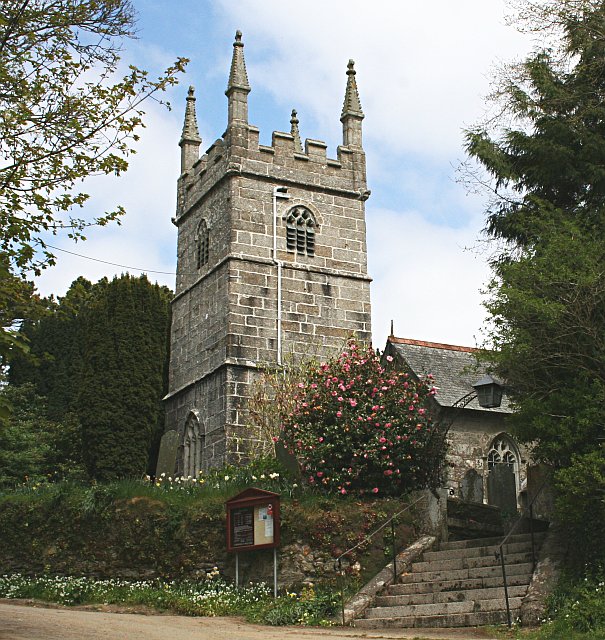St Piran’s Church is an active Anglican church in PerranarworthalMostly rural parish in West Cornwall., Cornwall. It is part the Eight Saints Cluster, made up of the parishes of Stithians with Perranarworthal and GwennapHamlet and civil parish in West Cornwall.[1] in the Diocese of Truro.
The church is dedicated to Saint Piran, whose Saints Day is on 5 March. Piran is considered to be the patron saint of tin miners and of Cornwall, along with St Michael and St Petroc.[2] The Grade II* listedStructure of particular architectural and/or historic interest deserving of special protection. church is built on an ancient site; the oldest part of the building is its 15th-century granite tower. The church was rebuilt and enlarged in 1882 by Piers St Aubyn. Its churchyard contains several listed tombs and headstones. Nearby is a holy well dedicated to St Piran.
History
St Piran’s Church is built on a site that has been used for worship possibly since Norman times, as evidenced by the tympanum over the south door.[3] The 15th-century tower is all that remains of the church that replaced the Norman chapel after its chancelPart of a church containing the altar, used by the officiating clergy. was rebuilt in 1842. The architect James Piers St Aubyn rebuilt the chancel in 1882, when the naveCentral part of a church, used by the laiety., aisle and porch were added. A vestry was added in the 20th century. The church was designated Grade II* listed status in May 1967.[4]
Structure
The tower is built of granite ashlarMasonry of squared and finely cut or worked stone, commonly used for the facing of a building. and the rest of the church is constructed of killas[a]Killas is an important sequence of rocks underlying two-thirds of Cornwall formed from sediments metamorphosed by heat emanating from the granites.[5] rubble with dressed granite details. It is roofed with Delabole slate.[4]
The west tower has three stages divided by string courses and an embattled parapet with pinnacles at each corner. The belfryStructure in which bells are hung. has Perpendicular Gothic openings with slate louvres, quatrefoil tracery and have hood moulds with arches above them. Its four-centred doorway has a 19th-century door.[4]
The nave and chancel are under the same roof. The south aisle has a vestry at its east end. Except for the tower, the windows are from the 19th-century rebuild in matching Perpendicular style. The north wall has a chancel window and four nave windows with three or two lights. At the east end is the aisle gable with a three-light window and the projecting chancel gable has a three-light traceried window. The south wall has a window to the left of the porch and four to the right, all but one have two lights. The aisle’s west gable has a three-light window. The 19th-century porch entrance and its inner doorway have pointed arches.[4]
Interior
The chancel’s six-bay arcade has granite columns and pointed arches. The roof is arch-bracedStructural framework of timbers designed to bridge the space above a room and to provide support for a roof. and wind-braced. Above the doorway is a Norman tympanum decorated with the Lamb of God from an earlier building.[3][4]
The octagonal granite font is possibly of late-medieval date but was reworked in the 19th-century rebuild. The pulpit over a moulded granite base and the pews also date from the 1882 rebuilding.[4]
The church displays a letter from King Charles I from 1643, which has a painted coat of arms on the reverse. Monuments include a Classical marble wall monument to Benjamnin Sampson, who died in 1840. The coloured glass in the east window is dedicated to John Jose of Mellingey, and coloured glass in a south aisle window to geologist William Jory Henwood, who died in 1875.[4] The tower has a ring of six bells.
Churchyard
The churchyard wall is constructed of killas rubble with granite entrance gate piers, steps and copings and wrought iron railings. They were built in the 19th century and are Grade II listed structures.[6] Within the churchyard are several Grade II listed headstones and chest tombs. They include a thin slate headstone from 1768 and a nowy-headed headstone from 1821.[7][8] The graveyard also contains a group of five rectangular chest tombs: two are incised slate slabs on brick bases from 1789 and 1800, and a ground level slate slab is from 1789. An 1808 chest tomb has an incised slate slab on a granite ashlar base, and another from 1839 has panelled granite sides and lid with an incised slate insert. An 1845 headstone of white limestone encloses a panelled chest with an obelisk on a triangular pedimentLow-pitched gable above a portico or façade..[9] A square chest tomb from 1813 is made of white limestone. It has a plinth with a moulded top, panelled sides and is surmounted by an urn.[10]
St Piran’s Well
A short distance from the church is St Piran’s Well, an early to mid-19th century, Grade II listed structure on an ancient site. The well has a granite ashlar front and a granite lintel over the entrance and is roofed with granite lintels. Inside, the square shallow well, cut into the hillside, is fed by a natural spring.[11]
Notes
| a | Killas is an important sequence of rocks underlying two-thirds of Cornwall formed from sediments metamorphosed by heat emanating from the granites.[5] |
|---|



